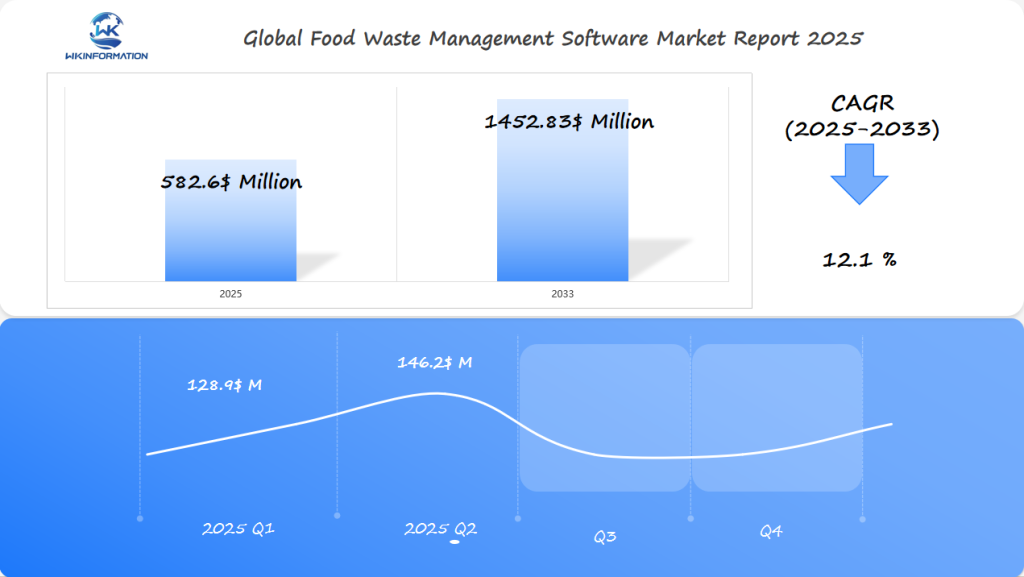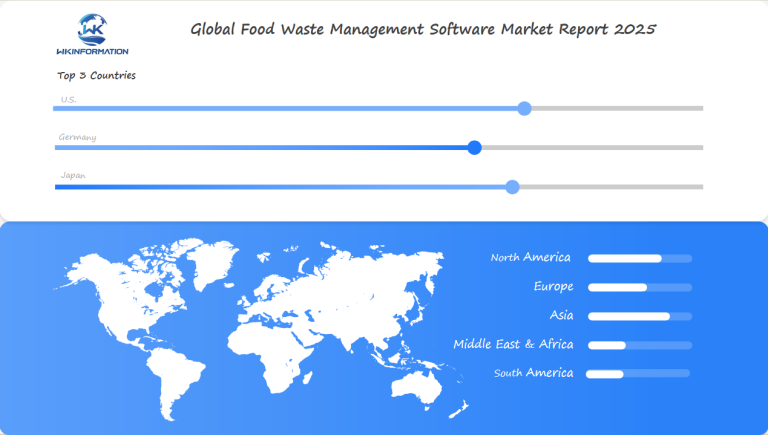Food Waste Management Software Market Poised to Reach $582.6 Million Globally by 2025: Strategic Insights Across the U.S., Germany, and Japan
Discover key insights into the Food Waste Management Software Market, including growth trends, leading vendors, and emerging technologies shaping the industry through 2025.
- Last Updated:
Food Waste Management Software Market Q1 and Q2 2025 Performance Insights
The Food Waste Management Software market is on track to reach a valuation of $582.6 million by the close of 2025, underpinned by a projected CAGR of 12.1% between 2025 and 2033. Preliminary estimates suggest the market will generate around $128.9 million in Q1 2025, followed by a stronger performance of approximately $146.2 million in Q2 2025.
This uneven distribution reflects real-world dynamics such as seasonal implementation cycles, fiscal budgeting behaviors, and varying levels of investment readiness among enterprises. Strategically, the United States, Germany, and Japan are emerging as pivotal markets, supported by aggressive regulatory frameworks, heightened technological integration in waste management systems, and a growing emphasis on achieving corporate sustainability goals. These regions are expected to set the pace for innovation and adoption trends throughout the year.

Key Takeaways
- Global food waste management software market expected to reach $582.6 million by 2025
- Technological innovations driving sustainable waste reduction strategies
- Multiple industries adopting digital waste management platforms
- Economic and environmental benefits motivating software implementation
- Data-driven approaches transforming waste management practices
Unlocking Growth Potential Across the Food Waste Management Software Upstream and Downstream Chain
The food waste management software industry is changing how we manage supply chains. It uses new tech to help businesses cut down on waste. This is done by creating detailed plans to tackle waste at every stage of food production and delivery.
Today’s advanced software is changing how we track and reduce food waste. It gives companies real-time data to make smart choices. This helps them tackle waste more effectively.
Key Strategic Approaches in Waste Reduction
- Implementing predictive analytics for inventory management
- Tracking product lifecycle from production to consumption
- Developing intelligent distribution network optimization
- Creating consumer engagement platforms
Supply chain optimization is key for businesses wanting to cut down on waste and work better. The software available today helps companies:
- Spot waste fast
- Get demand forecasts right
- Make logistics smoother
- Reduce extra inventory
By using smart waste reduction strategies, companies can save money and help the planet. The future of managing food waste is in smart, connected software. It turns old supply chains into modern, flexible networks.
Key Trends Shaping the Future of Food Waste Management Software
The world of food waste management is changing fast thanks to new technologies. These innovations use AI, IoT sensors, and blockchain to tackle food waste better than before.
New tech is changing how we track and cut down on food waste. AI now helps predict and prevent waste in ways we couldn’t before.
Technological Innovations Driving Change
- AI in waste management: algorithms analyze consumption patterns
- IoT sensors: provide real-time tracking of food inventory
- Blockchain technology: enhances supply chain transparency
IoT sensors are getting smarter at watching food quality and waste. They can spot temperature changes, track food, and warn about spoilage.
Breakthrough Monitoring Technologies
| Technology | Primary Function | Impact |
| AI Analytics | Predictive Waste Modeling | Reduces waste by 30-40% |
| Blockchain | Supply Chain Tracking | Increases transparency |
| IoT Sensors | Real-time Monitoring | Improves inventory management |
Blockchain is making food waste management better by keeping track of food. It makes sure food movement is clear and helps find supply chain problems.
These technologies are a big step forward in fighting global food waste. Companies can now use data to make smarter choices about food.
What's Holding Back the Food Waste Management Software Market? Analyzing Major Restrictions
The food waste management software market faces big challenges. These include complex technology, money, and rules issues. Businesses must carefully navigate these barriers.
Companies meet many hurdles when looking at food waste software. Small and medium-sized businesses find it hard to decide on tech investments.
Key Obstacles in Market Expansion
- High initial implementation costs
- Limited return on investment projections
- Complex regulatory compliance requirements
- Technological infrastructure gaps
Regulatory compliance is a big challenge. Different places have different rules for tracking and managing food waste. This makes it hard for software makers and users.
| Challenge Category | Primary Impact | Potential Solution |
| Financial Barriers | High software acquisition costs | Scalable pricing models |
| Technological Limitations | Infrastructure deficiencies | Modular software design |
| Regulatory Issues | Compliance complexity | Standardized reporting frameworks |
Digital literacy and tech awareness are key to overcoming these challenges. Companies need to invest in training and support. This helps them use food waste management software well.
Even with these hurdles, the chance for better sustainability and cost savings keeps driving innovation. This is true for this growing market segment.

How Geopolitical Changes Are Shaping the Food Waste Management Software Industry
The world of food waste management software is changing fast. This is thanks to big changes in global politics. New partnerships between countries are changing how we tackle waste.
Every region has its own way of dealing with food waste. Countries are using different strategies. These reflect their economic goals and environmental values.
Strategic Global Partnerships Driving Innovation
Big changes are happening in food waste management software. This is thanks to partnerships across borders:
- European Union nations working together on waste tracking
- North American tech companies using advanced analytics
- Asian markets investing in AI for waste reduction
Technological progress in one area quickly spreads to others. International collaborations are helping to share knowledge and develop new solutions.
Emerging Policy Frameworks
World governments recognize the significance of technology in addressing food waste issues. In response, they are formulating new regulations to promote groundbreaking software solutions that facilitate tracking, forecasting, and minimizing waste within intricate supply networks.
Amidst the ever-evolving landscape of global politics, food waste management software is at the forefront of this movement. It holds the potential for more efficient and environmentally-friendly methods of overseeing our food systems.
Understanding Food Waste Management Software by Type: Growth Areas and Opportunities
The world of food waste management software is changing fast. It now offers many solutions to fight global food waste. Companies can pick from various software types, each meeting different needs and tech preferences.
There are key tools for businesses looking to manage waste well:
- Cloud-based solutions: offer flexible, scalable ways to track waste
- On-premise systems: manage data locally, securely
- Hybrid platforms: mix cloud and local tech for the best of both
Cloud-Based Solutions: The Emerging Frontier
Cloud-based solutions are becoming more popular in food waste management. They allow for real-time tracking, easy data sharing, and access from anywhere. Small to medium businesses like them because they’re affordable and easy to set up.
On-Premise Systems: Traditional Reliability
On-premise systems are still important for those who need strong data security. They give full control over data, making them great for big companies and those with strict rules.
Hybrid Approaches: Bridging Technology Gaps
Hybrid solutions are the most advanced, blending cloud ease with on-premise safety. They let businesses manage food waste in a flexible, secure way.
Food Waste Management Software Applications: Where Demand is Surging
The market for food waste management software is growing fast. Companies are using new tech to tackle big waste problems.
Many sectors are finding special uses for these advanced systems. They help track and manage waste in various ways. This makes it easier to monitor and improve in different fields.
Innovations in the Restaurant and Food Service Industry
Restaurants are using smart software to change how they handle waste. Key features include:
- Real-time inventory tracking
- Predictive ordering algorithms
- Waste reduction performance analytics
Retail and Supermarket Waste Management
Supermarkets are adopting new ways to cut down on waste. They use advanced software to:
- Optimize stock rotation
- Forecast demand accurately
- Reduce unnecessary buying
Agricultural and Manufacturing Applications
Advanced tracking systems are being used in food processing and farming. Precision management tools help reduce waste throughout the entire supply chain.
These new software tools are a significant advancement in managing food sustainably. They provide a clear understanding of waste and assist in finding ways to minimize it.
Mapping Regional Developments in the Global Food Waste Management Software Market
The global food waste management software market is growing fast in different parts of the world. Each area has its own way of using new technology to fight food waste. This shows how different regions are leading in using technology to solve these problems.
Looking at the market in different places shows how each area is growing in its own way:
- North America: Starting new tech solutions with strong software bases
- Europe: Strict rules pushing the market to grow
- Asia-Pacific: Fast tech use and new market chances
- Latin America: More people learning about and using software
Market Penetration Strategies
Looking at how regions grow shows what matters for food waste software. The way technology is used varies a lot, affecting how software is adopted.
Important points aboutregional market trends include:
- Custom software for local problems
- More money for research and development
- Government help for green waste tech
- Working together between tech makers and industry players
Emerging Market Opportunities
The world of food waste management software is always changing. Each region has its own special traits and growth chances. To lead in technology, it’s key to know what each region needs and create software just for them.

U.S. Food Waste Management Software Market: Opportunities and Outlook
The U.S. food waste management software market is undergoing significant transformations. This is attributed to the emergence of new technologies and a growing number of individuals prioritizing environmental concerns. Innovative startups are at the forefront, offering solutions to reduce food waste across various sectors.
Key Strategies Driving Growth in the U.S. Food Waste Management Market
The U.S. food waste management market is experiencing rapid expansion due to several key strategies:
- Implementation of advanced data analytics platforms for effective tracking of food inventory
- Adoption of real-time waste monitoring technologies to gain insights into waste generation patterns
- Utilization of predictive software for optimizing supply chain processes and minimizing food waste
Policy Impact and Innovation Drivers
Government actions are accelerating the adoption of innovative software solutions in food waste management. The Environmental Protection Agency’s Food Recovery Challenge is a significant contributor, promoting the use of technology to minimize waste.
Market Potential and Investment Landscape
The U.S. food waste management software market has a lot of promise. Venture capital is backing tech solutions that offer big environmental and economic gains.
Germany's Role in the Global Food Waste Management Software Surge
Germany leads in food waste management software, thanks to its focus on the circular economy and advanced tech. It’s known for smart solutions to big environmental problems. This makes it a global leader in this field.
Germany’s success in food waste software comes from several key steps:
- Starting smart city projects with the latest waste tracking tech
- Creating detailed software for reducing waste
- Putting a lot of money into research for circular economy solutions
Technological Innovation and Global Impact
German companies have developed advanced software solutions that effectively track and reduce food waste. These platforms leverage artificial intelligence and real-time data to provide comprehensive insights into waste management practices.
Germany’s commitment to green technology has led to the global popularity of its software solutions, which are recognized for:
- High-quality software engineering
- Robust data protection and privacy measures
- Proven methods for waste tracking and reduction
Global Export of Waste Management Technologies
German food waste software is now sold globally, setting high standards for efficiency and sustainability. Its tech expertise continues to drive innovation worldwide. This demonstrates the effectiveness of circular economy strategies.
Japan's Growing Influence on the Food Waste Management Software Market
Japan is at the forefront of food waste management technology, thanks to its cultural values and the implementation of artificial intelligence (AI). The country has established itself as a global leader in efforts to minimize food waste, primarily through its emphasis on technological innovation and waste reduction strategies.
The Role of Technology in Japan’s Waste Management
While technology plays a significant role in Japan’s waste management approach, it is not the sole focus. The country is leveraging AI capabilities to monitor and mitigate food waste effectively. These technological advancements are strongly influenced by the cultural norms and practices prevalent in Japan.
Key Technological Breakthroughs
- AI-powered waste sorting systems that can identify and categorize food waste with unprecedented accuracy
- Machine learning algorithms that predict food waste patterns in restaurants and food service industries
- Robotic solutions for efficient waste processing and recycling
Market Impact and Future Potential
| Technology Category | Market Potential | Expected Growth |
| AI Waste Sorting | High | 15-20% annually |
| Predictive Waste Management | Medium-High | 12-18% annually |
| Robotic Waste Processing | High | 18-25% annually |
As the world seeks sustainable solutions, Japan’s technology in food waste management is at the forefront. The combination of cultural mindfulness and technology in Japan plays a crucial role in transforming waste management practices worldwide.
Forecasting What Lies Ahead for the Food Waste Management Software Market
The food waste management software market is about to undergo significant changes. New technologies and shifts in consumer shopping habits are driving this transformation. As a result, businesses are reevaluating their waste reduction strategies and placing greater emphasis on sustainability.
Several key trends are expected to shape the market in the coming years:
- Advanced AI integration for predictive waste analysis
- Real-time tracking systems with quantum computing capabilities
- Enhanced transparency in food supply chain management
- Increased sustainability-focused consumer demands
Technological Disruption and Market Evolution
Artificial intelligence will be key in changing food waste management software. Predictive algorithms will help businesses avoid waste before it happens. This will make operations more efficient.
The market is expected to grow fast as companies see the benefits of managing waste well. People wanting to buy sustainable products will also help the software grow in different industries.
Emerging Market Dynamics
Experts say we’ll see a lot of big companies buying up new startups. New business models will focus on the circular economy. This will lead to advanced software that helps reduce waste.
Competitive Forces Driving the Food Waste Management Software Sector
The food waste management software market is very competitive. Leaders are trying to be the top. Companies are forming alliances to get ahead and change how we deal with waste.
Key Players:
-
Leanpath – United States
-
Winnow – United Kingdom
-
Spoiler Alert – United States
-
ReFED – United States
-
Phood Solutions – United States
-
FoodLogiQ – United States
-
Lavu – United States
-
ClearCogs – United States
-
Food Rescue US – United States
-
TotalCtrl – Norway
Big players in the field stand out by focusing on sustainability and new tech. They use different strategies to stay ahead:
- Creating advanced algorithms for tracking waste.
- Developing platforms that connect many groups.
- Working on easy-to-use mobile apps.
- Expanding their partnerships worldwide.
Strategic Partnerships Driving Market Growth
Top companies are forming partnerships to expand their market reach. Tech firms are collaborating with:
- Restaurant chains
- Agricultural groups
- Sustainability research centers
- Government environmental teams
These alliances aim to address significant waste management challenges. Technological innovation is crucial in this competitive industry, as companies continuously develop improved solutions for monitoring and minimizing waste.
Investment and Market Positioning
Companies are investing heavily in research and development. The most successful ones are focusing on creating software that can truly transform our approach to managing food waste.
Overall
| Report Metric | Details |
|---|---|
| Report Name | Global Food Waste Management Software Market Report |
| Base Year | 2024 |
| Segment by Type |
· Cloud-Based · On-Premise |
| Segment by Application |
· Restaurant and Food Service Industry · Retail and Supermarket · Agricultural and Manufacturing · Others |
| Geographies Covered |
· North America (United States, Canada) · Europe (Germany, France, UK, Italy, Russia) · Asia-Pacific (China, Japan, South Korea, Taiwan) · Southeast Asia (India) · Latin America (Mexico, Brazil) |
| Forecast units | USD million in value |
| Report coverage | Revenue and volume forecast, company share, competitive landscape, growth factors and trends |
The food waste management software market is key to making industries more sustainable worldwide. It’s growing fast, with expected values of $582.6 million by 2025. Success in this field depends on new tech and knowing the local markets well.
Technological innovation is driving success in this market. Companies using advanced software with AI, data analytics, and real-time tracking are leading the way. They need adaptable platforms that can handle different waste management issues in various regions.
Regional markets are important for growth. North America and Europe are ahead in tech adoption. But, Asia-Pacific is showing fast growth. The best companies will offer flexible, scalable software that fits with local waste systems.
The future looks bright for food waste management software. It offers chances for new tech and sustainable growth. Companies focusing on data, understanding local needs, and staying tech-savvy will thrive in this changing market.
Global Food Waste Management Software Market Report (Can Read by Free sample) – Table of Contents
Chapter 1: Food Waste Management Software Market Analysis Overview
- Competitive Forces Analysis (Porter’s Five Forces)
- Strategic Growth Assessment (Ansoff Matrix)
- Industry Value Chain Insights
- Regional Trends and Key Market Drivers
- Food Waste Management Software Market Segmentation Overview
Chapter 2: Competitive Landscape
- Global Food Waste Management Software Players and Regional Insights
- Key Players and Market Share Analysis
- Sales Trends of Leading Companies
- Year-on-Year Performance Insights
- Competitive Strategies and Market Positioning
- Key Differentiators and Strategic Moves
Chapter 3: Food Waste Management Software Market Segmentation Analysis
- Key Data and Visual Insights
- Trends, Growth Rates, and Drivers
- Segment Dynamics and Insights
- Detailed Market Analysis by Segment
Chapter 4: Regional Market Performance
- Consumer Trends by Region
- Historical Data and Growth Forecasts
- Regional Growth Factors
- Economic, Demographic, and Technological Impacts
- Challenges and Opportunities in Key Regions
- Regional Trends and Market Shifts
- Key Cities and High-Demand Areas
Chapter 5: Food Waste Management Software Emerging and Untapped Markets
- Growth Potential in Secondary Regions
- Trends, Challenges, and Opportunities
Chapter 6: Product and Application Segmentation
- Product Types and Innovation Trends
- Application-Based Market Insights
Chapter 7: Food Waste Management Software Consumer Insights
- Demographics and Buying Behaviors
- TargetAudience Profiles
Chapter 8: Key Findings and Recommendations
- Summary of Food Waste Management Software Market Insights
- Actionable Recommendations for Stakeholders

Access the study in MULTIPLEFORMATS
Didn’t find what you’re looking for?
TALK TO OUR ANALYST TEAM
Need something within your budget?
NO WORRIES! WE GOT YOU COVERED!
Call us on: +1-866-739-3133
Email: infor@wkinformation.com
What is the projected market size for food waste management software by 2025?
The market for food waste management software is expected to grow to $582.6 million by 2025. This growth is due to more people becoming aware of environmental issues. It also comes from the need for better waste management in different industries.
How are AI and machine learning impacting food waste management software?
AI and machine learning are changing food waste management. They help predict waste, manage inventory better, and give insights into waste generation in real-time. This is across the whole food supply chain.
What are the main challenges facing food waste management software adoption?
Challenges include high costs to start, doubts about getting a good return on investment, and tech barriers in some areas. There’s also a lack of digital setup and strict data privacy rules.
Which regions are leading in food waste management software development?
- North America leads in tech adoption.
- Europe is growing the market with strict rules.
- The Asia-Pacific region has a lot of potential for fast growth.
What technologies are most important in food waste management software?
Key technologies are AI, machine learning, IoT sensors, blockchain, and advanced analytics. These help monitor waste in real-time and predict waste reduction.
How are different industries implementing food waste management software?
Industries such as restaurants, retail, and agriculture are adopting these solutions with the goal of:
- Reducing waste
- Improving supply chains
- Managing perishable goods more effectively
What role do government initiatives play in food waste management software adoption?
Government programs like the EPA’s Food Recovery Challenge in the U.S. and circular economy policies in Germany are key. They drive innovation, offer support, and create rules that encourage the use of food waste management software.
What are the different types of food waste management software available?
There are three main types of food waste management software:
- On-premise systems
- Cloud-based systems
- Hybrid systems
Each type has its own benefits, suited to different needs and tech levels.
How is IoT contributing to food waste management?
IoT devices and sensors track food quality and temperature. They predict shelf life and send alerts to prevent waste. This optimizes inventory management in the food supply chain.
What future trends are expected in food waste management software?
Future trends include advanced AI, quantum computing, and more focus on consumer transparency. There will also be better predictive analytics and a push for sustainable waste reduction.


